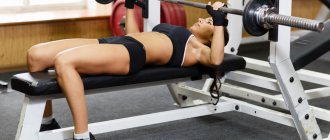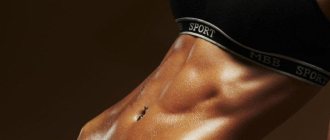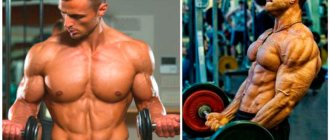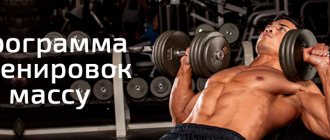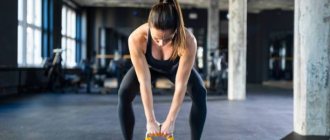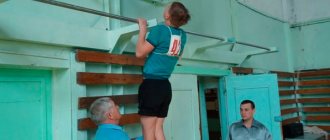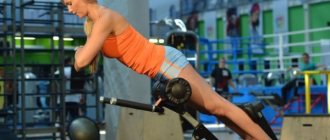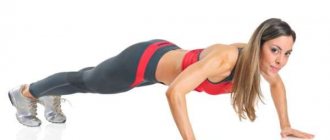Features of home weight training
A unique feature of the exercises necessary for gaining muscle mass, which are used in training at home, is the lack of much variety in sports equipment. This is a factor that does not allow increasing the load on a regular basis.
However, it is not at all necessary to purchase expensive exercise equipment; you can make do with improvised means at the initial stage, and then gradually purchase a minimum set in the form of dumbbells, a horizontal bar, parallel bars, and, if possible, a barbell. In any case, you can make a completely effective home gym and save a significant amount of money without going to a fitness club.
What you need for home training
Due to the lack of trainers at home to monitor the correctness and effectiveness of training, you should approach this process yourself.
- First of all, you need to make all your workouts regular. With sporadic exercise and the absence of a full-fledged system, it is impossible to achieve even a slight increase in strength and endurance, much less it is impossible to build muscle mass.
- You should give up bad habits that distract you from playing sports. This applies to smoking and drinking alcohol. Well-known scientists have found that after drinking only 50-100 g of strong alcohol, the entire positive effect of mass-building training comes to naught.
- Before each lesson you need to warm up. This rule is observed even by professional athletes with a high level of training. Otherwise, any, even the simplest, exercises will lead to injuries. The duration of the warm-up is usually 10-15 minutes, during which warm-up exercises are performed for the muscles and ligaments.
- You can't overwork yourself. Professional trainers and fitness instructors recommend setting your workout time at home around 1-1.5 hours.
- To effectively gain muscle mass, you should take long breaks between approaches. Unlike endurance training, in which the break is approximately 30 seconds, for mass-building exercises this value should be quadrupled.
- Any workout should be completed with a cool-down. This will avoid heart problems and improve recovery. Standard stretching, running or cycling, if available, is best.
Don't miss the most popular article in the section: Body drying for girls. Training program, detailed nutrition menu for the month by day.
7 Basic Exercises for Home Workouts
Pushups
If you are very strong at push-ups, you can use the isometric pre-exhaustion method. Pause for 5-10 seconds in the bottom position of the push-up (don't lie on the floor!), and then complete the set. This method greatly increases the neuromuscular connection with the chest and triceps muscles. Which leads to significant muscle hypertrophy.
Your results will depend entirely on your ability to make the exercise more difficult in the coming weeks. You have two options:
- Increase weights (weight vest, backpack with sand, use of a training partner and fitness bands).
- Increasingly difficult variations of push-ups (on a ball, dive bomber, with a clap, on one arm, with feet elevated).
The basic rule: if you can easily perform more than 10 repetitions, then you need to either add weight or complicate the technique. It's not enough to just do these exercises - you need to progress every week, and then the muscles will grow.
Pull-ups on the horizontal bar
The one movement that everyone should do: beginners and veterans alike, at home and in the gym.
This is the best exercise for creating an attractive V-shaped figure (wide shoulders and narrow waist).
For training the biceps brachii muscle, pull-ups on the bar are more effective than barbell curls..
It’s definitely impossible to do without them, so now there is a large selection of convenient and inexpensive horizontal bars that can be easily installed at home.
Moreover, pull-ups with a reverse grip are more effective for training the biceps, while straight ones are more effective for the back muscles. Therefore, it is better to alternate them.
For example:
- 1st approach - straight grip.
- 2nd approach - reverse grip.
- 3rd approach - straight grip.
Or in reverse order.
Or do it with a forward grip on Mondays, and a reverse grip on Thursdays.
If you still can’t do 10 pull-ups in one approach, then you can start with Australian (reverse) pull-ups.
You can start with them, they will help develop the necessary muscles. When you can easily perform 10-15 Australian pull-ups, move on to traditional pull-ups on the horizontal bar or alternate them in different workouts.
If you are very strong at pull-ups, then there is an option to dramatically increase the load and neuromuscular connection with the biceps and latissimus dorsi by slowly performing the exercise. Do the first few reps very slowly: 3 seconds up, 6 seconds down, and then complete the set at a normal pace.
Reverse push-ups
Gradually adding weight in the form of a sand backpack or weighted vest while performing reverse push-ups will make your arms larger and more powerful.
Here you can also use pre-exhaustion through a very slow negative phase of the movement: as you lower (the body moves down) do this for as long as possible - 6-10 seconds.
Squats
The same principle applies as in push-ups.
There is no point in doing 100 squats at a time.
Although this is of course not true. This is exactly 100 times better than doing nothing at all. But our goal remains the same: to make bodyweight squats the most effective.
You need to try to add so much weight that even with great difficulty you will not be able to squat more than 10 times per approach. If you can train like this for many weeks, then muscle growth in your legs is almost guaranteed, especially if you are not a bodybuilding veteran.
What options do we have: add weight (weight vest, backpack with sand, sit someone on your back, kettlebells or dumbbells), make the movement more difficult (unilateral “one-legged” exercises).
Of all the gym exercises, the most difficult to replicate at home is squats with a barbell.
This is one of the most indispensable exercises. But when you train at home, you either need to constantly increase the weight or make it more difficult for yourself. If adding weight seems quite difficult, then isometric pre-fatigue comes to the rescue. Fix your body in a half-squat position for 10-60 seconds (depending on your level of training).
And then do as many reps as you can. The main thing is that at 10-12 repetitions you reach muscle failure.
Single leg squats
Stepping onto a bench (step-up)
But, most likely, you will quickly see that even without weights it will be difficult for you to do 10 repetitions.
In addition, the higher the bench or cabinet, the more difficult it is to perform and the greater the stimulation of muscle fibers. The same box or bench can also be used for reverse push-ups and one-legged squats.
Due to the large range of motion, this exercise is more effective than even classic squats. A good workout for the quadriceps and buttocks.
Ab crunches
So, we have listed the 7 most effective exercises, now we will combine them into a program.
A typical four-day split using free weights in the gym looks like this:
- Monday: chest, back, triceps, abs.
- Tuesday: legs, shoulders, biceps, cardio.
- Wednesday: closed.
- Thursday: chest, back, triceps, abs.
- Friday: legs, shoulders, biceps, cardio.
- Saturday: closed.
- Sunday is a day off.
Home training should be built on the same principle.
This method of dividing different muscle groups by day allows you to effectively work out all muscle groups and at the same time give them enough time to recover.
It is important that you have enough rest days to fully recover and be able to work very intensively. That's why there are three days off.
This way, you can train hard without risking overtraining.
Cardio
In this way we further compensate for the lack of gym weights. As mentioned, the effectiveness of a heavy barbell at home is quite difficult to replicate. Therefore, our training should be as focused as possible on muscle growth and include intense cardio.
Things like jumping with a weighted rope, running at maximum speed (sprinting), and burpees are great for this. You need to choose an exercise that you can perform for 30 seconds at a VO2 max of 80%-90% for five intervals.
This is what it looks like:
- Burpee (maximum intensity) - 30 seconds.
- Rest two minutes.
- Burpee (maximum intensity) - 30 seconds.
- Rest two minutes.
- Burpee (maximum intensity) - 30 seconds.
- Rest two minutes.
- Burpee (maximum intensity) - 30 seconds.
- Rest two minutes.
- Burpee (maximum intensity) - 30 seconds.
On the subject: Training of Hollywood male stars
You need to perform the movement so intensely (maximum 80-90% VO2) that you literally begin to choke from lack of air. The total duration of such a cardio session is about 15-20 minutes.
You can also do the same with sprinting (running at top speed). Or jumping with a weighted rope. You can also alternate and combine all these exercises.
The most important criterion is to keep your heart rate really high.
The main point is not the exercise you choose. Your goal is to increase your heart rate to 150-160 beats per minute. How to check this:
Immediately after each interval, count your pulse for 10 seconds (much easier to do this on the carotid artery) and multiply the result by 6.
According to numerous studies, it is as a result of such training that growth hormone is released, which accelerates fat burning and muscle growth.
Ideally, you should do two such cardio sessions per week.
But if you can’t do it yet, then in the first couple of weeks one cardio workout will be enough.
Basic exercises for beginners
Exercises for gaining muscle mass at home for beginners should be selected taking into account physical fitness. In a fitness club, a trainer draws up a program for the client and then the trainer monitors and controls all processes; at home, you need to do everything yourself.
The effectiveness of muscle growth and the safety of ligaments and joints directly depend on how correctly and accurately the approaches are done. It is important to take into account that women and men have different physical capabilities; therefore, for the fairer sex, the number of approaches and repetitions in each exercise should be reduced by 20-50%.
- The most important exercise to increase muscle size is simple push-ups. You should start with 3-4 sets of 10-15 push-ups at a time. Hands can be placed close to each other or, conversely, spread wide. In this case, different muscles are involved in the process of performing exercises.
- The next basic home exercise is pull-ups on the horizontal bar. You should also do 3-4 sets of 7-12 times. The grip greatly influences which muscles are worked. With a wide grip, the back develops first, with a narrow grip, the triceps, and with the opposite grip, the biceps.
- Another mandatory exercise is crunching. It must be performed correctly, otherwise the effectiveness drops to zero. Lying on your back, you should slowly raise your upper body, which should gradually become rounded from a straight position. Important! At this point, many people make the mistake of simply raising their upper body straight and trying to touch their forehead to their knees. In this case, the abdominal muscles are almost not used, the back muscles work. To control the exercise, you can place your fingers just above and below the navel, and if twisted correctly, they will gradually move closer to each other. You should do 3-4 approaches at a slow pace of 15-20 repetitions. A higher number will increase endurance, not muscle size.
- Squats are mandatory. Hands behind your head, back straight, you need to lower yourself as much as possible and then slowly return to the starting position. You should perform 3-4 sets of 20-30 times.
All of these exercises should be made more difficult to develop strength and endurance. This is done by increasing the number of repetitions, approaches and introducing weights.
A set of exercises for gaining muscle mass at home
Beginners who want to gain weight, but do not have the opportunity to go to the gym, often begin to fear that this activity is difficult to implement at home.
We would like to assure you that gaining weight at home can be even more effective if you build a set of workouts correctly. The basis of mass gain consists of two stages: proper nutrition and productive training. We will consider nutrition issues at the end of the article, now we will focus on training.
Mass gain training consists of three main types: pressing, pulling and weight training. All three types have excellent home execution options:
- Pressing training will perfectly help you make the most ordinary floor. In fact, to perform them you just need a comfortable surface from which you can comfortably push off.
- Pulling training requires some kind of support to reach for. A horizontal bar is suitable for this. The horizontal bar can be installed at home or found at a nearby site.
- Weight-bearing exercises can be performed with a heavily stuffed backpack strapped to your back. You can also make home dumbbells of the required weight with your own hands in a fairly simple way.
Pressing and pulling exercises pump different muscle groups. Their alternate execution helps to fully strengthen the muscle corset. Weight training helps build overall endurance and strength, and also makes initially simple exercises significantly more difficult.
To ensure successful training, you can add several recommendations to the general program:
- It is better to warm up before training. The exercises themselves are performed at a fairly intense pace. An abrupt start to intensive training can negatively affect muscles that are still cooled and have not yet been put to work. Light warm-up movements will save joints and muscle tissue.
- After your workout, do a gentle cool-down. A cool-down is needed to gradually reduce the pace and takes up to 5 minutes. Just slow down the intensity of the movements or do a series of simple exercises at a slower pace.
- Finish with stretching. Even when gaining weight, stretching is an important attribute of training. Flexibility exercises help speed up muscle recovery and prepare the body for proper rest.
These three simple principles will significantly reduce the time of initial adaptation to exercise and contribute to the rapid development of muscle mass.
Now let's look at the basic exercises for building the program itself.
Building muscle mass in the arms
The best way to quickly build mass is, of course, doing push-ups and pull-ups. Push-ups work the entire arm muscles, as well as the upper pectoral and back muscles. Depending on your current goals, push-ups can be performed with different arm widths, different speeds, and different additional functions.
It is important to do pull-ups without convulsive movements of the legs: try to perform the exercises accurately and quickly. Helping yourself with your legs is only allowed when you are no longer able to climb the horizontal bar without it.
1. Standard push-ups. Place your hands at a comfortable width. Push-ups are done all the way down, this will also allow you to best work the pectoral muscles.
2. Standard pull-ups. Hands are placed with a standard grip, shoulder-width apart.
3. Close grip pull-ups. The brushes are placed close to each other. This position puts increased stress on the triceps.
3.1. Reverse grip pull-ups. The exercise additionally strengthens the back of the hands and helps to work hard-to-reach muscles.
Building muscle mass on the chest
For home workouts, push-ups are a truly wonderful exercise: by slightly changing the principles of their implementation, you can achieve a more complete pumping of the chest. Changing the placement of the width of the arms switches the exercise and the main load begins to go to the inner part of the arms, upper and lower pectoral muscles.
1. Supported push-ups (legs on support, torso down). This exercise also gives a good load on the shoulder joints and upper pectoral muscles.
2. Supported push-ups (torso on support, legs down). This exercise is ideal for pumping up the lower pectoral muscles. It is useful to use it in combination with the previous option.
3. Push-ups between supports. Place two strong objects that you can lean on while performing push-ups. The chest should be lowered as low as possible between the arms. The exercise allows you to work even the thinnest chest muscles.
4. One-arm push-ups. This is an exercise for virtuosos. One-arm push-ups are accessible to people with strong physical fitness. If your general physical fitness is not so strong, then you can rest your other hand on something strong: a chair, a sofa chair, a stack of books or a kettlebell. This will allow you to help yourself when lifting your body up.
Building muscle mass in the shoulders
Building mass on the shoulders occurs through the simultaneous use of triceps and deltoids. To do this, choose exercises that put stress on the upper arms, neck and shoulders. Correct variations of the same push-ups and pull-ups are used as such exercises.
1. Reverse push-ups. The exercise is performed with support on your hands. The hands are placed behind the back, the body is straight. Lower yourself down to the maximum possible position, after which you level off to the starting position. The legs provide additional support, which helps to carry out the exercise.
2. Vertical push-ups. Raise your legs and press your heels against the wall. Do push-ups until your head completely touches the floor to thoroughly work out all the delta muscles.
3. Push-ups with narrow arms. The exercise puts increased stress on the shoulders.
Building muscle mass in the legs
To build up leg muscles, it is enough to perform a set of squats and lunges. Exercises can be combined with each other and performed in various variations. Each option gives full load to the legs, but highlights different muscle groups in the legs a little more. The combination of all exercises gives a general pumping of the legs and a good load on the terrain.
1. Squats.
2. Lunges forward. Lunges can be done with additional weight to achieve a greater load.
2.1. Side lunges.
3. Lifting onto your toes. The exercise is most effective when performed on the edge of some surface (for example, on the edge of a sofa).
Building muscle mass on the abs
Full abdominal pumping is achieved through standard abdominal exercises, which are often used in home fitness.
1. Raising your legs.
2. Upper press.
3. Raising your legs at the knees.
Building muscle mass on the back
Building mass for the back muscles occurs through various types of reverse push-ups and special variations of pull-ups.
1. Wide grip pull-ups.
2. Pull-ups by the head.
3. Dips.
Mass exercises for intermediate levels of training
Exercises to more effectively gain muscle mass for an average level of training at home are expected to become more difficult. The approach to their implementation is changing. It is already mandatory to have at least a minimum set of sports equipment.
It is necessary to create a complete program that, depending on the day of the week, will offer workouts for the upper or lower body. Fitness club instructors recommend paying attention to the muscles located in the upper body on Monday and Thursday, and on Tuesday and Saturday, respectively, to the lower body. All other days should be devoted to rest and recovery.
When training the upper body, it is necessary to use equipment whose weight should not cause excessive tension in the muscles after the first approach. Unlike fat-burning workouts, the exercises described below should not be performed in a circle. Only after completing all approaches of one should you move on to the other.
- The most important thing is training the biceps. The dumbbells or barbell are raised from the lowest, most relaxed position to the shoulders, the elbows are not raised, there are no jerks. You should perform 3 to 4 sets of 18-25 times.
- After this, move on to training the triceps by doing French bench press, the safest for joints, in contrast to standing and sitting positions. The arms are at an angle of 90 degrees, straighten smoothly, the elbows always remain in place, no jerking. It is necessary to perform 3 to 4 approaches of 10-18 times.
- Finally, barbell or dumbbell bench press. In this case, you should use a regular grip at shoulder level. The equipment is pulled up to the chest, without being lowered onto it, to avoid injury. Straighten your arms smoothly and without jerking. It is necessary to perform at least 3 sets of 6-8 times. It is imperative, as with all exercises, to carry out the last approach until failure and burning in the muscles
While working out the lower body, you should also perform one exercise after another, as slowly and smoothly as possible.
The last approaches are carried out until failure and muscle pain:
- The most important exercise is the regular deadlift. It is advisable to perform it with a barbell. The back must absolutely be straight, deviation is fraught with damage. Simultaneously with the body tilting forward and slightly downward, the arms and the barbell smoothly lower below the knees. In this case, there should be 3 approaches. You should not perform too many repetitions in one approach, because this exercise is treacherous and dangerous - it can cause unexpected damage.
- Squats with a barbell. The back is straight, the bar is placed on the shoulders and held with the hands. The deepest possible squat is smoothly carried out, and then a smooth rise. No jerking, otherwise there will be no muscle growth. There should be at least 4 approaches, with the number of squats at a time being about 8-10 times.
- The third most important exercise of the complex is regular lunges. As with all lower body exercises, arching your back is strictly prohibited. It's easier to use dumbbells instead of a barbell. A step and squat are taken until a right angle is formed in the leg. Then they return to their original position and change legs. You should perform 3 to 4 sets of 12-14 lunges with both legs at a time.
6 Week Home Workout Program
The 6-week rotation is designed to keep the workout more interesting: each week you do a different number of reps and continually increase the weight or difficulty of the movements.
Rest between sets 1.5-2 minutes.
Week 1 (3 sets of 12 reps total):
Monday (chest, back, arms, abs)
- Pushups.
- Pull-ups on the bar with a straight grip.
- Reverse push-ups.
- Ab crunches (3 sets of 10-15 reps).
Tuesday (legs, cardio).
- Double leg squats (with weights or isometric pre-exhaustion - freeze in a half squat for 10-60 seconds).
- Single leg squats.
- HIIT - cardio (5 intervals of 30 seconds - burpees).
Wednesday is a day of rest.
Thursday (chest, back, arms, abs).
- Pushups.
- Pull-ups on the bar with a reverse grip.
- Reverse push-ups.
- Ab crunches (3 sets of 10-15 reps).
Friday (legs, cardio).
- Stepping onto a box (bench).
- Single leg squats.
- HIIT - cardio (5 intervals of 30 seconds - burpees).
Saturday/Sunday - rest.
Week 2 (3 sets of 10 reps for all):
All exercises and schedule remain the same, but you increase the complexity of the movement or perform it with additional weight (if the first week you did push-ups from the floor on your knees, then you can try moving on to push-ups with a clear correct technique, and in squats on two legs, or take heavier weight, or do longer isometric pre-exhaustion). You need to ensure that 8-10 repetitions in the 3rd approach of each exercise are given to you with great difficulty , and not just stop at the tenth repetition.
Helpful tip : Try to do the last set of each exercise until muscle failure.
Week 3 (3 sets of 8 reps).
The same thing, only you need to increase the weight or complexity of the exercises compared to the previous week.
Week 4 (4 sets of 6 reps).
Following the same scheme, but increasing the weights even more.
Week 5 (4-5 sets of 4 reps).
We make the exercises even more difficult so that in the last approach of each exercise we reach muscle failure at 2-4 repetitions.
Week 6 (5 sets of 10, 8, 6, 4, 2 reps - reverse drop set).
Drop sets are widely used in bodybuilding in order to “shock” the muscles and increase muscle volume.
We train according to the same scheme as in the previous days, but we do 10 repetitions on the first approach, and only 2 on the last approach. You need to rest for 2-3 minutes between sets. For the first set, you use a fairly light weight that you can do 10 reps with. With each set, you either make the exercise more difficult or add weight - moving from fairly light resistance to super-heavy resistance so that the maximum weight is on the last set.
For example, pull-ups on the horizontal bar: 10, 8, 6, 4, 2. You either add weight or increase the load by lowering your body very slowly in a controlled manner.
This option is possible: do 2-3 sets of Australian pull-ups, and the last 2-3 sets of classic pull-ups on the bar.
Week 6 is, as it were, the result of all previous training. And the use of non-standard methods - reverse drop sets, helps increase muscle fiber hypertrophy.
Week 7 (repeat week 1). An exact repeat of the first week, but now you are stronger and so you need to use heavier weights.
Week 8 - 12 . Just repeat everything from weeks 2 to 6 with heavier weights, or constantly increasing the complexity of the exercises.
Training for professionals
The principle of the exercise program for gaining the necessary muscle mass among professionals is very different from those described above. The system, even at home, resembles a full-fledged workout in a fitness club. Each session focuses on a different muscle group. This allows you to effectively combine heavy exercise and much-needed rest.
On Monday you should do the following exercises for the arm muscles, the weight of the equipment is heavy:
- Barbell curls for biceps. The back is straight, when returning to the original position, the arms should be relaxed and stretched as much as possible. 4 approaches are performed, during each of which the equipment is raised 7-8 times.
- Triceps exercise with French press. Due to the heavy weight of the equipment, it is recommended to perform it from a lying position to preserve joints. Perform 4 sets of 6-10 repetitions.
- You need to complete the set with a biceps exercise, but using dumbbells. Lifting dumbbells is performed alternately with each hand. The total number of approaches is 4, and the number of repetitions is from 10 to 12.
On Tuesday, exercises work the chest muscles, the weight of the equipment is heavy:
- The first and most important exercise is the classic bench press. The number of approaches is 3, in each of which 12-15 repetitions should be performed.
- Weighted push-ups. 3 approaches, performed at a slow pace until failure.
- You should complete the set with a dumbbell bench press. 3-4 approaches are performed, all should be done to failure. Perform at least 10 repetitions at a time.
On Wednesday, all muscle groups are given rest. Without proper recovery, the rate of muscle growth will drop to minimal levels and may even be negative.
On Thursday, they focus on the back muscles, the weight of the equipment is heavy:
- The main exercise is the bent-over barbell row. 3 approaches are performed, with a total number of repetitions per stage from 8 to 10.
- Then you should perform bends with a barbell on your shoulders. It is strictly forbidden to arch your back, which can lead to injury. Perform 3 approaches, with the number of repetitions from 10 to 12.
On Friday they do shoulder exercises, the weight of the equipment is heavy:
- The dumbbells are being raised. If the exercise is done in a straight position, then the front and middle deltoids are trained, if in a forward bend, then, accordingly, the rear deltoids. Perform 4 approaches, with a total number of repetitions at a time from 10 to 15.
- Perform the so-called “Arnold press” or in other words, dumbbell press up. 3 approaches are done, with the number of repetitions at a time from 12 to 15. The exercise is performed to failure.
Here's how to do the Arnie press - a very effective exercise for gaining muscle mass at home - Shrugs with a barbell or dumbbells. The total number of approaches is 3, and the number of repetitions is from 8 to 10.
On Saturday, leg exercises are done, the weight of the equipment is heavy:
- Squats with a barbell or dumbbells. Approaches – from 3 to 4, repetitions – from 6 to 9.
- Deadlift. Approaches – from 3 to 4, repetitions – from 6 to 9.
- Lunges with dumbbells or barbell. Sets 4, reps 12 to 15.
Sunday should be a day off, without any activity.
Don’t miss the most popular article in the section: Glutamic acid - what it is, why and how it is used in sports and bodybuilding.
Difficulty exercising at home
And after a certain period of time, home exercises turn into cardio training, because there is no progression of the load.
Regularly performing 20 or more push-ups will lead to the development of endurance, not muscle growth. The same applies to squats 100 times in one approach. The body perceives such training as cardio load and therefore the muscles practically do not change.
Cardio training is not harmful, that's not the point.
They are essential for burning fat, maintaining metabolism and the cardiovascular system.
But this article is not about losing weight and burning fat, but about how to gain muscle mass at home.
The main goal of this workout is to make your muscles grow.
The biomechanics of all exercises are practically no different from the movements you would do in the gym. We will only add load progression to bodyweight exercises.
For example:
- Bench press = push-ups.
- Barbell squats = bodyweight squats.
- Pull-ups on the bar = pull-ups on the bar.
- Overhead extension (French press) = reverse push-ups (from a bench).
We assume that we don’t have barbells, plates or heavy collapsible dumbbells at home.
The training is aimed at increasing the strength load when performing exercises with your own weight.
Mass exercises with dumbbells
For any exercise to effectively gain muscle mass, you need to use certain equipment, and this does not depend on where the training takes place, in the gym or at home. The most affordable to purchase and use are regular dumbbells.
Exercises with dumbbells aimed at increasing muscle mass can be divided into two categories:
- Basic exercises.
- Isolated exercises.
Basic exercises include:
- Squat with dumbbells. Quadriceps and buttock muscles develop. Dumbbells - in each hand, perform a full squat with them and slowly return to the original position.
- Deadlift. The body is initially tilted forward. There is a deflection in the lumbar region, and the body drops further forward and down. The arms must be parallel to the legs and fall just below the knees. Do not bend your back, which could result in serious injury.
- Lunges. Alternate steps are taken forward and lowered into a squat with different legs. The back is straight, arms with dumbbells are lowered along the body.
- Climbing onto the bench. You should alternately step on a bench or any other surface with different feet. The knee must not be moved beyond the foot.
- Dumbbell press. Can be performed in a sitting or lying position. The hands holding the dumbbells are at the same level and simultaneously rise up and then lower to the starting position.
Basic exercises work many different muscle groups at the same time. However, the greatest effectiveness in developing muscle mass can be achieved by alternating both basic and isolating exercises , listed below.
- Lifting dumbbells for biceps. Performed in a sitting or standing position. Hands with dumbbells are lowered, from this position they slowly, without jerking, rise to the shoulders and then return back.
- French bench or standing triceps press. Hands with dumbbells are raised up, then slowly lowered back until an angle of 90 degrees is formed, then returned to the starting position.
- Dumbbell lateral raises on the deltoid muscles. It is performed in a straight position, in which the front and middle deltoids are trained, or in a forward bending position, in which the rear deltoids are trained. Hands with dumbbells are lowered and then simultaneously raised until a straight line is formed with the shoulders.
Progression of load when training at home
Therefore, if you can easily complete 40 push-ups in one approach, then you need to find a way to make it difficult to do 10.
We have two options:
- Use additional tools and equipment.
- Improvise.
If you get creative, one of the best options is to use a training partner. Here's how to do it for squats and push-ups.
But after a while you will become stronger and you will need to constantly look for a larger partner to increase the load.
Pull-ups on their own are a heavy exercise and most people don’t need additional weights. However, if you can easily do more than 10 reps, just find a way to add weight.
Another option for increasing the load is the use of additional tools and equipment.
Expanders (fitness bands), platforms, dumbbells, kettlebells, a weighted vest or a belt with a chain for weights.
For example, weight vests allow you to gradually add up to 70 kg of weight, they are quite comfortable and are used in many sports. Suitable for almost any exercise.
The use of elastic bands for fitness allows you to significantly diversify the load and work out a variety of muscle groups. In addition, they vary in degree of rigidity and the likelihood of injury when using them is much lower.
One of the main problems at home is leg training.
If you've done barbell squats in the past, you know that you have to put quite a lot of weight on the bar before the bar becomes so heavy that you can't do more than 10 squats with it in one set.
Therefore, at home, it is best to do unilateral “one-legged” exercises and step-ups (stepping onto a box) . They are more dangerous, but much heavier than traditional squats. Simply use a bench, box, or platform and do the exercises with each leg at a time. And always remember about safety: the platform must be stable, reliable and not slip.
On topic: Home workout for intensive weight loss
One of the main benefits of single-legged exercises is that the range of motion increases significantly and it becomes very difficult to complete a set of 6-10 repetitions.
Especially if you have a kettlebell or dumbbells in your hands.
We've listed just a few ways to make your home workout more effective.
As the load increases, type 2 fast muscle fibers are activated . And this is a key point for muscle hypertrophy.
How to recover after a workout
Any physical activity requires good rest. During the rest period, you should give up all bad habits. They are incompatible with a healthy lifestyle. In addition to smoking and drinking alcohol, you should avoid night parties, as well as watching TV and using gadgets before bed.
You need to sleep a lot, especially at night. This is due to the fact that during this period of time chemical processes associated with the restoration and construction of muscles take place. New fibers are formed and damaged ones are repaired. This is a fact that has been proven by sports doctors and specialized scientists.
How to eat healthy
In addition to rest, proper nutrition is an essential factor in muscle recovery and growth. During the day, a person who is actively training should eat 5 to 7 times. Everything must be clearly calculated and planned.
Food must have a high level of nutrition, without this the body will simply destroy all calories during grueling workouts, in other words, the number of calories consumed must exceed the number of calories expended.
There are several mandatory rules; first of all, you should almost completely get rid of junk food that interferes with muscle growth:
- sweet;
- roast;
- flour products;
- canned food
Any food that is eaten must contain the necessary nutrients. It is important to maintain the correct balance of BJU. The amount of protein per 1 kg of weight for successful growth of muscle tissue should be at least 1.5-2 g.
The optimal product is boiled chicken breast. Protein shakes can also help achieve this goal. You should try to shift your carbohydrate intake to the first half of the day.
They must be slow and have at least an average glycemic index. The best choice, according to professional bodybuilders, is oatmeal. Thin people also need an extra boost of the right carbohydrates, which are found in mass gainers. Be sure to include a lot of greens and vegetables in your diet. This will improve digestion.
To summarize, several quite clear conclusions should be noted. Exercises for effectively gaining muscle mass can be used both during training in a fitness club or gym, and at home.
